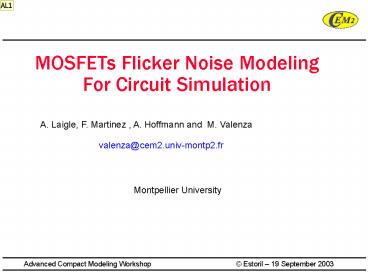MOSFETs Flicker Noise Modeling For Circuit Simulation - PowerPoint PPT Presentation
1 / 47
Title:
MOSFETs Flicker Noise Modeling For Circuit Simulation
Description:
Estoril 19 September 2003. Advanced Compact Modeling Workshop. MOSFETs Flicker Noise Modeling For Circuit Simulation. Montpellier University ... – PowerPoint PPT presentation
Number of Views:420
Avg rating:3.0/5.0
Title: MOSFETs Flicker Noise Modeling For Circuit Simulation
1
MOSFETs Flicker Noise Modeling For Circuit
Simulation
A. Laigle, F. Martinez , A. Hoffmann and M.
Valenza
valenza_at_cem2.univ-montp2.fr
Montpellier University
2
Outline
- Introduction
- Methodology and Instrumentation
- 1/f modeling
- 1/f theory
- 1/f models
- Experimental results
- Conclusion
3
Introduction (1)
- Low frequency noise is important for
- Conduction phenomena and random noise
- - White noise (thermal shot noise)
- - 1/f and origin (?N, ? µ, ? N- ? µ) RTS
G.R. - - High electric field multiplication
- - Correlation between two noise sources
- Technologies evaluation
- - Reliability, quality, aging
- - Parasitic elements, defects
- - Equivalent circuit
- Analog applications with mixed CMOS technologies
(LN amplifiers, oscillators, sensors ) - We need models
4
Introduction (2)
5
DRAIN CURRENT NOISE (3)
- Fundamental
- thermal noise
- Excess noise
- RTS
- 1/f
6
GATE CURRENT NOISE (4)
- Fundamental level
- Shot noise
- Excess noise
- RTS
- 1/f
7
Introduction (5)
- Drain current spectral density is dependent of
- Technology process
- Oxide thickness
- Mobility
- Channel geometry (W, L)
- Access resistances
- Biases
Are commercial simulators well suited ?
- Gate current spectral density few
investigations up today
8
Outline
- Introduction
- Methodology and Instrumentation
- 1/f modeling
- 1/f theory
- 1/f models
- Experimental results
- Conclusion
9
USED METHODOLOGY
Good model for F.E.T devices. ic source-drain
noise generator ? transistor channel ig
gate-source noise generator ? command electrode
/channel
Direct measurement of
Coherence
10
Simultaneous measurements
11
EXPERIMENTAL SETUP
12
Transimpedance Amplifier
13
Voltage Amplifier
14
Cross Spectrum Measurements
eA
eA
15
Low noise Amplifiers
Voltage Amplifier
Transimpedance Amplifier
Bandwidth 0.5Hz-1MHz/200Hz-30MHz
1 Hz- 200 KHz
Gain 1000
108 107 106 ?
Input Imped. 1 M? - 15 pF/ 1 M? - 50 pF
1 ? - 10 k?
Noise equival. 40 ? / 35 ?
500 pA 50 nA 2 ?A
Direct measure of SI(f) Under low impedance
Direct measure of SI(f) Under strong impedance
Used for
16
Drain noise measurements
eA(t)
iRp(t)
Ch(t)
17
Drain noise measurements
VS(t)
RC
iA(t)
ich(t)
18
Outline
- Introduction
- Methodology and Instrumentation
- 1/f modeling
- 1/f theory
- 1/f models
- Experimental results
- Conclusion
19
1/f noise theory
- Noise source due to conductivity fluctuations ?
q µ n - three models
- Hooge model (?µ)
- SPICE
- Mc Whorter model (?N)
- correlated model (?N- ?µ) BSIM
20
?N model
Weak inversion
Strong inversion i) linear regime
ii) saturation regime
21
Typical NMOS results
22
?µ model
Weak inversion
Strong inversion i) linear regime
ii) saturation regime
23
Typical PMOS results
24
CORRELATED MODEL (?N- ?µ)
Fluctuation of oxide Trapped carriers quantity
Fluctuation of carriers number and of their
mobility
- ? Coulomb scattering coefficient
- ? the electron tunneling constant in the oxide
- NT oxide trap density
25
CONTRIBUTION OF ACCESS RESISTANCES
26
CONTRIBUTION OF ACCESS RESISTANCES
27
Access resistance noise
28
SPICE Simulations
SPICE 1980
NLEV0
SPICE 1996
NLEV1
HSPICE
NLEV2 and 3
29
BSIM MODEL
Weak inversion
Strong inversion
and
with
Continuity between weak and strong inversion
30
BSIM MODEL
31
Outline
- Introduction
- Methodology and Instrumentation
- 1/f modeling
- 1/f theory
- 1/f models
- Experimental results
- Conclusion
32
Typical Results
33
PMOS Results TOX1.5 nm
34
NMOS Results TOX1.5 nm
35
PMOS TOX 1.3 nm W10µm, L0.35µm
Ohmic Range
NOIA 2,2.1020 (V-1.m-3) NOIB 8,7.106
(V-1.m-1) NOIC 8,6.10-8 (V-1.m)
36
PMOS TOX 1.3 nm W10µm, L0.35µm
Ohmic Range
VT
NOIA 2,2.1020 (V-1.m-3) NOIB 8,7.106
(V-1.m-1) NOIC 0 (V-1.m)
37
PMOS TOX 1.3 nm W10µm, L0.35µm
Saturation Range
VT
NOIA 2,2.1020 (V-1.m-3) NOIB 8,7.106
(V-1.m-1) NOIC 8,6.10-8 (V-1.m)
38
Saturation Range
PMOS TOX 1.3 nm W10µm, L0.35µm
VT
NOIA 2,2.1020 (V-1.m-3) NOIB 8,7.106
(V-1.m-1) NOIC 0 (V-1.m)
39
PMOS TOX 1.5 nm W0.3µm, L10µm
Ohmic Range
VG1V
VT
NOIA 1.1022 (V-1.m-3) NOIB 2,6.106
(V-1.m-1) NOIC 7.10-11 (V-1.m)
40
PMOS TOX 1.5 nm W0.3µm, L10µm
Ohmic Range
NOIA 1.1022 (V-1.m-3) NOIB 2,6.106
(V-1.m-1) NOIC 0 (V-1.m)
41
PMOS TOX 1.5 nm W0.3µm, L10µm
Saturation Range
NOIA 1.1022 (V-1.m-3) NOIB 2,6.106
(V-1.m-1) NOIC 7.10-11 (V-1.m)
42
PMOS TOX 1.5 nm W0.3µm, L10µm
Saturation Range
VT
NOIA 1.1022 (V-1.m-3) NOIB 2,6.106
(V-1.m-1) NOIC 0 (V-1.m)
43
PMOS TOX 1.5 nm
VDS -25 mV
44
Gate current noise (PMOS TOX 1.5 nm)
VDS -25 mV
45
Coherence measurements(PMOS TOX 1.5 nm)
VDS -25 mV
46
Conclusion
SPICE and HSPICE models are not well suited for
1/f noise
BSIM3 is a good fitting model
Thinner and thinner gate oxide ? new noise sources
47
Conclusion































